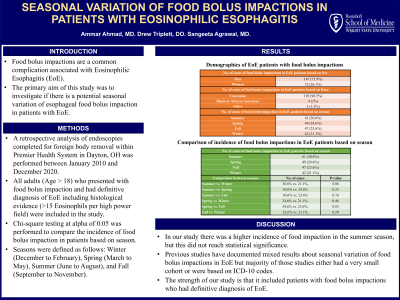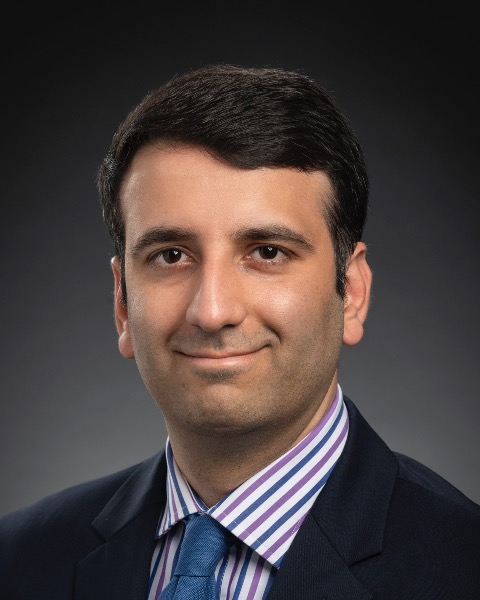Monday Poster Session
Category: Esophagus
P2205 - Seasonal Variation of Food Bolus Impaction in Patients With Eosinophilic Esophagitis
Monday, October 28, 2024
10:30 AM - 4:00 PM ET
Location: Exhibit Hall E

Has Audio

Ammar Ahmad, MD
Wright State University
Tipp City, OH
Presenting Author(s)
Ammar Ahmad, MD1, Drew Triplett, DO2, Sangeeta Agrawal, MD2
1Wright State University, Tipp City, OH; 2Wright State University, Dayton, OH
Introduction: Eosinophilic Esophagitis (EoE) is a chronic, immune/antigen-mediated esophageal disease characterized clinically by symptoms related to esophageal dysfunction and an identifiable eosinophilic infiltrate on biopsies in the absence of other etiologies. Food bolus impaction is a common complication associated with EoE. Reports and small retrospective studies have suggested that patients with EoE are more likely to present with food bolus impaction during summer and fall. The primary aim of our study was to investigate if there is a seasonal variation in esophageal food bolus impaction in patients with EoE in Dayton, OH area.
Methods: A retrospective analysis of endoscopies completed for foreign body removal within Premier Health System in Dayton, OH was performed between January 2010 and December 2020. All adults (Age > 18) who presented with food bolus impaction and had definitive diagnosis of EoE including histological evidence ( >15 Eosinophils per high power field) were included in the study. Chi-square testing at alpha of 0.05 was performed to compare the incidence of food bolus impaction in patients based on season. Seasons were defined as follow: Winter (December to February), Spring (March to May), Summer (June to August), and Fall (September to November).
Results: In total, 982 cases of food bolus impaction were identified. Of these, only 199 patients (20.3%) had definitive diagnosis of EoE including histological evidence. The mean age of patients with EoE who presented with food bolus impaction was 39.8 years. 147 (73.9%) patients were male and 52 (26.1%) patients were female. Summer had the highest number of cases of food bolus impaction (61) and winter had the lowest (42). The difference between these seasons was not statistically significant (p = 0.06). The difference between other seasons also did not reach statistical significance (Table 1).
Discussion: In our study, there was a higher incidence of food impaction in the summer season, but this did not reach statistical significance. Previous studies have documented mixed results about seasonal variation of food bolus impaction in EoE but majority of those studies either had a very small cohort or were based on ICD-10 codes. The strength of our study is that it included patients with food bolus impaction who had definitive diagnosis of EoE. Further studies like this should be performed to figure out locoregional seasonal incidence of food bolus impaction in EoE patients across the United States.
Note: The table for this abstract can be viewed in the ePoster Gallery section of the ACG 2024 ePoster Site or in The American Journal of Gastroenterology's abstract supplement issue, both of which will be available starting October 27, 2024.
Disclosures:
Ammar Ahmad, MD1, Drew Triplett, DO2, Sangeeta Agrawal, MD2. P2205 - Seasonal Variation of Food Bolus Impaction in Patients With Eosinophilic Esophagitis, ACG 2024 Annual Scientific Meeting Abstracts. Philadelphia, PA: American College of Gastroenterology.
1Wright State University, Tipp City, OH; 2Wright State University, Dayton, OH
Introduction: Eosinophilic Esophagitis (EoE) is a chronic, immune/antigen-mediated esophageal disease characterized clinically by symptoms related to esophageal dysfunction and an identifiable eosinophilic infiltrate on biopsies in the absence of other etiologies. Food bolus impaction is a common complication associated with EoE. Reports and small retrospective studies have suggested that patients with EoE are more likely to present with food bolus impaction during summer and fall. The primary aim of our study was to investigate if there is a seasonal variation in esophageal food bolus impaction in patients with EoE in Dayton, OH area.
Methods: A retrospective analysis of endoscopies completed for foreign body removal within Premier Health System in Dayton, OH was performed between January 2010 and December 2020. All adults (Age > 18) who presented with food bolus impaction and had definitive diagnosis of EoE including histological evidence ( >15 Eosinophils per high power field) were included in the study. Chi-square testing at alpha of 0.05 was performed to compare the incidence of food bolus impaction in patients based on season. Seasons were defined as follow: Winter (December to February), Spring (March to May), Summer (June to August), and Fall (September to November).
Results: In total, 982 cases of food bolus impaction were identified. Of these, only 199 patients (20.3%) had definitive diagnosis of EoE including histological evidence. The mean age of patients with EoE who presented with food bolus impaction was 39.8 years. 147 (73.9%) patients were male and 52 (26.1%) patients were female. Summer had the highest number of cases of food bolus impaction (61) and winter had the lowest (42). The difference between these seasons was not statistically significant (p = 0.06). The difference between other seasons also did not reach statistical significance (Table 1).
Discussion: In our study, there was a higher incidence of food impaction in the summer season, but this did not reach statistical significance. Previous studies have documented mixed results about seasonal variation of food bolus impaction in EoE but majority of those studies either had a very small cohort or were based on ICD-10 codes. The strength of our study is that it included patients with food bolus impaction who had definitive diagnosis of EoE. Further studies like this should be performed to figure out locoregional seasonal incidence of food bolus impaction in EoE patients across the United States.
Note: The table for this abstract can be viewed in the ePoster Gallery section of the ACG 2024 ePoster Site or in The American Journal of Gastroenterology's abstract supplement issue, both of which will be available starting October 27, 2024.
Disclosures:
Ammar Ahmad indicated no relevant financial relationships.
Drew Triplett indicated no relevant financial relationships.
Sangeeta Agrawal indicated no relevant financial relationships.
Ammar Ahmad, MD1, Drew Triplett, DO2, Sangeeta Agrawal, MD2. P2205 - Seasonal Variation of Food Bolus Impaction in Patients With Eosinophilic Esophagitis, ACG 2024 Annual Scientific Meeting Abstracts. Philadelphia, PA: American College of Gastroenterology.
